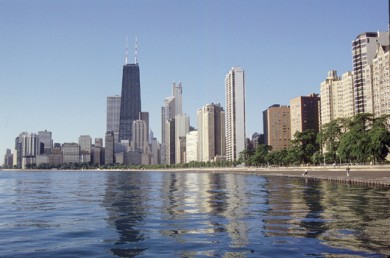Hispanic neighborhoods less green

Chicago’s primarily Hispanic and African American neighborhoods are further away from Lake Michigan and have less open space, a study finds.
Photo: Roberta Dupuis-Devlin/UIC Photo Services
Residents of Chicago’s Hispanic neighborhoods live farther from nature and its benefits than do residents of the city’s non-Hispanic neighborhoods, UIC researchers say.
The biologists studied four natural attributes — tree coverage; distance to Lake Michigan; distance to large, open green spaces; and bird diversity — of more than 820 census tracts in the city.
Lead author Amélie Davis, a postdoctoral researcher, says many surveys have looked at the distribution of green infrastructure across socioeconomic gradients, but most such studies have looked at just one natural attribute. The new study examined multiple environmental variables.
“It’s important to look at these patterns in Chicago,” Davis said, “because it is one of the most racially separated cities in the U.S.”
Using socioeconomic data from the U.S. Census Bureau’s 2005-2009 American Community Survey, the researchers found that three types of neighborhood stood out statistically: those predominantly housing low-income African Americans; those of low- to mid-income Hispanic residents; and those of the higher income group, which were not classified by race.
“We found that the high-income tracts and the low-income African American tracts essentially had about the same level of these environmental variables, except the latter group was significantly farther away from Lake Michigan,” Davis said.
In contrast, tracts with more low- to mid-income Hispanic residents “tend to be farther away from [both] Lake Michigan and open space, and the amenities they provide,” Davis said. Those tracts also have less tree cover and less biodiversity of bird species, she said — findings she called unexpected.
The researchers noted that the natural attributes they measured offer important health and social benefits.
Lake Michigan, which serves as the city’s source for drinking water, is also an important recreation venue. Tree canopies shade homes, reduce stormwater runoff, and remove pollutants from the air.
Open spaces, such as parks and forest preserves, offer recreational benefits, facilitate stormwater runoff, and help regulate microclimate. Birds — in addition to their esthetic value — can be an indicator of a neighborhood’s ecological health and offer benefits to humans in the way of seed dispersal and insect consumption.
“There is evidence that people who experience more greenness around them can feel better mentally and perform better on tasks,” said senior co-author Emily Minor, assistant professor of biological sciences at UIC. “That can be a problem if not all groups are getting these same benefits.”
Do the findings suggest environmental injustice in Chicago? Davis and Minor caution that further study is needed.
They speculate that the disparity could be due to the relatively recent arrival of Hispanic immigrants to Chicago, with their later arrival leading to settlement in locations with fewer trees and farther from the lake. They also note a possible public-knowledge gap about the value and importance of trees, or of municipal forestry services available.
“It could be residents don’t have as much access to the people who make decisions about where trees go,” Davis said. “If that is the case, extension services or local stewardship organizations should provide residents with the necessary information.”
Further study must also consider both the ecological health and the public safety of various open spaces, Davis said.
“If the parks that are in or nearby those tracts are of lesser environmental quality or are not safe enough to be visited, it’s like having nothing,” she said.
Other co-authors on the study are UIC graduate students Amy Belaire, Monica Farfan, Dan Milz, and Eric Sweeney, and Scott Loss of the Smithsonian Migratory Bird Center.
The findings are published in Ecosphere, an online journal of the Ecological Society of America.
